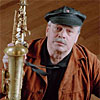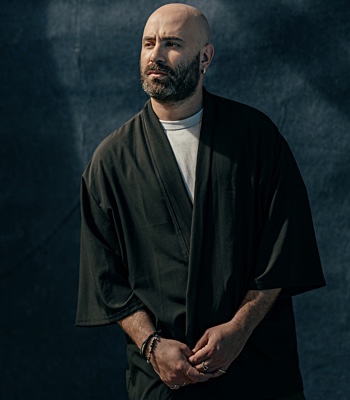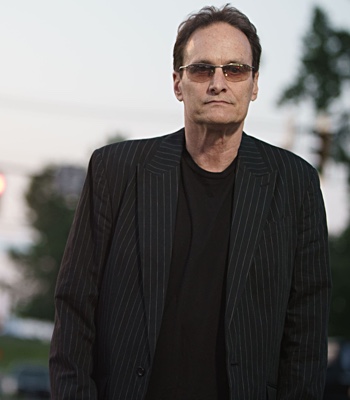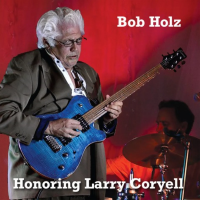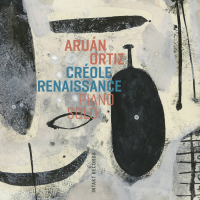Home » Jazz Musicians » Jim Snidero
Jim Snidero
Over the past thirty-five years, Jim Snidero has come to be known as one of the finest jazz musicians of his generation. As an alto saxophonist, composer, arranger, author and educator, Snidero has been called both a “master musician” and “alto saxophone virtuoso” by Downbeat Magazine, and placed in the 2017 Downbeat Critic’s Poll, demonstrating his continued impact on the international jazz scene.
Jim Snidero grew up in Camp Springs, Maryland, just outside of Washington, DC . Musically nurtured from a young age, both at home and in his school music program, Snidero began to quickly show promise as a musician. As a teenager, Snidero studied with the great Phil Woods and was a member of the famed One O’Clock Lab Band at the world-renowned jazz program at the University of North Texas. Studies with another saxophone great—Dave Liebman—helped Snidero to reach the next level as a musician and, ultimately, helped him to make the decision to move to New York at the conclusion of his college years.
After arriving in The Big Apple in 1981 at age 23, Snidero first appeared on the jazz radar when he joined Brother Jack McDuff’s band, recording 3 albums with a jazz giant. That proved to be the first of many notable sideman stints for the then-budding saxophonist. Word of his skills quickly spread, leading Snidero down other avenues with the Mingus Big Band, saxophone icon Frank Wess, the Toshiko Akiyoshi Jazz Orchestra, Eddie Palmieri, and Frank Sinatra (Duets II, Capitol), to name just a few.
Snidero became a leader on record with On Time (Toshiba/EMI 1984), the first of many notable dates that he would record under his own name. Over the quarter century that followed, he created an enviable body of work built with musical consistency and stylistic diversity. Highlights include Mixed Bag (Criss Cross, 1987), his first widely-available release, Blue Afternoon (Criss Cross, 1989), deemed one of the best jazz records in history in The Penguin Jazz Guide: The History Of The Music In The 1001 Best Albums, and Strings (Milestone, 2003) which he both composed and arranged for string orchestra, hailed a “masterpiece” by several major news organizations.
The last ten years has delivered a series of well-received dates for the prominent Savant record label. Snidero initially focused on a guitar-centric line-up, among other things teaming up with young modernists like bassist Linda Oh and drummer Rudy Royston for dazzling efforts like Stream Of Consciousness (Savant, 2013), resulting in Snidero placing in Downbeat Magazine’s 2014 Reader’s poll. He then pivoted to piano trio with Main Street (Savant, 2015) and quintet with MD66 (Savant, 2016) inspired by Miles’ Davis’ second great quintet, resulting in a critic’s pick in Jazz Times magazine.
Tags
Jim Snidero at the Bop Stop

by C. Andrew Hovan
A collection of photos from the Jim Snidero concert at The Bop Stop in Cleveland on March 7, 2025 featuring Jim Snidero, Peter Washington and Jason Tiemann. ...
Continue ReadingJim Snidero: For All We Know

by Alberto Bazzurro
Jim Snidero, californiano, sessantasei anni, collaborazioni che vanno da Tom Harrell a Frank Sinatra, è senza dubbio alcuno uno dei massimi paladini del mainstream jazz fin dai secondi anni Ottanta. Questo suo nuovo lavoro, inciso nell'ottobre 2023 nella tutto sommato singolare (nonché stimolante) formazione del trio senza pianoforte (o chitarra che sia), conferma appieno tale assioma, navigando su temi anche fra i più noti della letteratura jazzistica (nessun original), affrontati col giusto piglio e un'assoluta padronanza lessicale. ...
Continue ReadingJim Snidero: For All We Know

by Dan McClenaghan
The cover photo on Jim Snidero's For All We Know features the saxophonist holding his horn out in front of his body as if he is offering it to us as a holy relic. Holy it is when he plays it; a relic it is not. The album is Snidero's first recorded offering in a trio setting--sax, bass and drums. No chording instrument. His partners in chordlessness, Peter Washington and Joe Farnsworth--bass and drums, respectively--are a perfect choice, ...
Continue ReadingFar Out!

by Michael Ambrosino
Inside, outside and all around this genre, exists a remarkable array of music that all flows back to the unique source and sensibility known as jazz. This episode features Jim Snidero, Buster Williams, Nicholas Payton, Rebecca Nash, Kendrick Scott, Diego Rivera, Jane Bunnett & Maqueque, Joe Locke, Vince Mendoza, Nguyên Lê, Theo Croker and Lisa Marie Simmons. ...
Continue ReadingGoing Far Away with Jim Snidero

by David Bixler
In his early twenties, saxophonist Jim Snidero had surrounded himself with the music of the John Coltrane quartet and the Miles Davis quintet, however upon moving to New York City forty years ago and coming face to face with the tradition, he did an about face and dedicated himself to the pursuit of bebop. In the last decade he has used the foundation of the tradition do give breadth to more contemporary leanings. His new recording, Far Far Away featuring ...
Continue ReadingJim Snidero: Far Far Away

by Jack Bowers
There are many reasons for recording a jazz album, from “let's get together and create something fresh and exciting" to “well, it's about time we recorded another album." With all due respect, alto saxophonist Jim Snidero's latest recording, Far Far Away, seems to lean more toward the latter. That is not to suggest that it is less than respectable, as nothing Snidero does dips below that benchmark. On the other hand, at times it does seem as ...
Continue ReadingJim Snidero: Far Far Away

by Dan Bilawsky
Far Far Away brings us ever so close to the genius of Jim Snidero. An incandescent affair built upon the pillars of new partnership and continuing collaboration, it showcases a marked consistency in craftsmanship and inventiveness that leaves no doubt as to this artist's place in the jazz firmament. Of course, seasoned listeners need no reminders about his elevated status. The vaunted alto saxophonist has been delivering dynamic performances as a leader on record for the better part of four ...
Continue ReadingJazz at the Johns Hopkins Club Presents Alto Saxophonist Jim Snidero

Source:
Sara Donnelly
Baltimore, MD: The Johns Hopkins University in partnership with the Peabody Institute has launched a new jazz series, Jazz at the Johns Hopkins Club, an exciting concert experience for its alumni, associate members, and guests. The spring series will feature four outstanding concerts beginning with two sets by the Jim Snidero Quartet on February 25th for general and student admissions. Originally from Camp Springs, MD and hailed as an “alto sax virtuoso" and “master musician" by Downbeat Magazine, Jim Snidero ...
read more
Jim Snidero Quartet at the Rubin Museum in NYC 11/4/11

Source:
Two for the Show Media
Harlem in the Himalayas Jazz Series RMA · 150 W. 17 St., NYC 10011 · 212.620.5000 Friday November 4, 2011 @ 7:00 PM $18.00 in advance / $20.00 day of Member Price: $16.20 Jim Snidero-Alto Sax Peter Zak- Piano Paul Bollenback- Acoustic Guitar Ugonna Okegwo- Bass McClenty Hunter- Drums “To celebrate his performance, Jim Snidero has composed the “Rubin Suite," a three-movement work inspired by exhibits from the museum. One piece, “Temple" ...
read more
Jim Snidero - Interface (2011)

Source:
Something Else!
You'd think that a guy who possess impeccable tone and technique on the alto sax, has starred in the Toshiko Akiyoshi Jazz Orchestra and the Mingus Big Band, has led solid straight ahead records of his own for almost 25 years would be a household name in jazz circles. Jim Snidero isn't, but that's no fault of his. On May 31 he issued his 16th album, Interface, and this album provides even less reason to overlook him. This is his ...
read more
Saxophonsts Eric Alexander & Jim Snidero at Chris' Jazz Cafe on September 27, 2008

Source:
All About Jazz
Eric Alexander, aka Alexander the Great," the title of one of his two dozen albums as a leader, will be appearing at Chris' Jazz Cafe on September 28, 2008.
Since placing second in 1991 to Joshua Redman in the Thelonious Monk Institute's saxophone competition, Alexander -- equally impressive on hard swinging numbers and romantic ballads -- has played on some 100 albums featuring some of the biggest names in jazz.
September 27, 2008 Sets @ 8 & 10pm ...
read more
Saxophonist Jim Snidero at Smoke, May 2-3

Source:
All About Jazz
May 2-3 Jim Snidero Strings on Milestone Records A Record Release Event at Smoke 2751 Broadway (between 105 & 106 Sts.) NYC Sets 9-11-12:30 $18 cover 212-864-6662 http://www.smokejazz.com
Featuring: Jim Snidero- alto sax, flute Renee Rosnes- piano Paul Gill- bass Billy Drummond- drums
Critical acclaim for Strings:
“Dramatic, intense and ...
read more
Saxophonist Jim Snidero at Smoke May 2-3

Source:
All About Jazz
May 2-3, 2003 Jim Snidero Strings on Milestone Records A record release event at Smoke 2751 Broadway (between 105 & 106 Sts.) NYC Sets 9-11-12:30 $18 cover 212-864-6662 www.smokejazz.com
Featuring:
Jim Snidero- alto sax, flute, Renee Rosnes- piano, Paul Gill- bass Billy Drummond- drums
Critical acclaim for Strings
“Dramatic, intense and compelling ...
read more
Jim Snidero: While Your Here (Red Records)

Source:
All About Jazz
Jim Snidero Quartet While Your Here 1. While Your Here 2. Intimacy 3. A Few To Many 4. Fly Little Birdie 5. State Of Affairs 6. I Concentrate On You 7. I Can't Get Started 8. Fron Line Jim Snider: altosaxophone Benny green: piano Peter Washington: bass ...
read more
“Alto Saxophone Virtuoso”- Downbeat Magazine
“Master Musician”- Downbeat Magazine
“Snidero has a quality that makes you trust him implicitly: taste”- Stereophile Magazine
“Genuinely significant figure in jazz composition”- Penguin Guide to Jazz

















